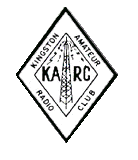|
The following article was printed in "The Kingston
Whig-Standard" on their "The People Page", Monday 11 July
2005, after The Sky's The Limit Festival.
Photo and article are
Copyright © Jack Chiang/The Whig-Standard
Amateur radio buffs are hamming it up

|
NOT TOO LONG AGO, THE AMATEUR
radio was a popular and inexpensive means of two-way communication
anywhere in the world. Today, the cellphone and the Internet have
made such communication much easier and more accessible.
It's a wonder that we still have amateur
radio clubs. But we do, and there's even one in Kingston. |
"Unfortunately, we're not as
strong as 20 years ago due to the insurgence of cellphones and the
Internet," said club president Robert Parker.
"Basically, our membership is stable. We're a bunch of
citizens who use the radio to chat back and forth. It's a large
community worldwide.
"We can talk to people anywhere in the world. I've
chatted with hams in Japan, Russia, the former Yugoslavia and so
on. We can make many friends that we don't see, although sometimes
people travel around the world to meet each other," Parker
said.
Amateur radio operators are called hams, although the
origin of the name isn't know. Hams must be licensed.
"We usually offer classes once a year. We just
graduated 13 new hams so our membership remains stable."
Parker said when there's an emergency, people often depend
on ham operators.
"During the ice storm, we provided communication
services. During the blackout a few years ago, we provided
communication services in the city.
"When the electrical grids go down, and cellphones
don't work, we can still provide the service because most of our
members have their own generators. A lot of us also use wind power
and solar power."
Right after the Sept. 11, 2001 terrorist attacks, Parker
said, "a lot of hams came up and running in New York.
Whenever there is an emergency, we take some stress out of the
police workload. When there is no emergency people tend to forget
us."
Amateur radios are available for as little as $100. More
sophisticated versions can cost thousands of dollars, Parker said.
Ham radio operators can talk to each other over a wider
area than CB (Citizen Band) radio. The latter is more local.
Most members in Kingston are older, so there's a need to
recruit younger members. "It's hard to get young people
involved but I blame the hams for not emphasizing what we do. Our
members are getting older and, unfortunately, some older members
have passed away.
"Ham radio is a beautiful thing. It'll never go out of
vogue. It'll always be needed."
- Jack Chiang
You can read more of Jack Chiang at The
Kingston Whig-Standard website.
Note: In the above picture of Rob, The callsign shown,
VE3SFD, is the callsign used during the Scouts Canada Jamboree on
the Air (JOTA), during the Green Wing Conservation Camp. VE3SFD is
sponsored for the Kingston Area Scouts by a Club member. The
Kingston Amateur Radio Club provides operators and equipment
during this camp. During Club operations, the callsigns VE3KBR,
VE3KAR, and VE3UEL, are normally used.
(KARC webmaster) |
|

